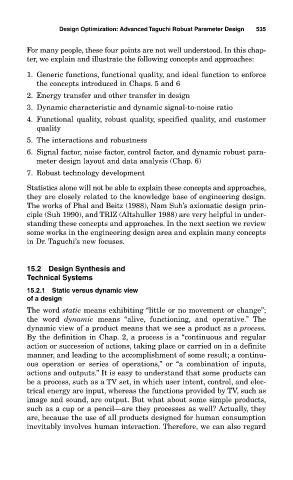Page 577 - Design for Six Sigma a Roadmap for Product Development
P. 577
Design Optimization: Advanced Taguchi Robust Parameter Design 535
For many people, these four points are not well understood. In this chap-
ter, we explain and illustrate the following concepts and approaches:
1. Generic functions, functional quality, and ideal function to enforce
the concepts introduced in Chaps. 5 and 6
2. Energy transfer and other transfer in design
3. Dynamic characteristic and dynamic signal-to-noise ratio
4. Functional quality, robust quality, specified quality, and customer
quality
5. The interactions and robustness
6. Signal factor, noise factor, control factor, and dynamic robust para-
meter design layout and data analysis (Chap. 6)
7. Robust technology development
Statistics alone will not be able to explain these concepts and approaches,
they are closely related to the knowledge base of engineering design.
The works of Phal and Beitz (1988), Nam Suh’s axiomatic design prin-
ciple (Suh 1990), and TRIZ (Altshuller 1988) are very helpful in under-
standing these concepts and approaches. In the next section we review
some works in the engineering design area and explain many concepts
in Dr. Taguchi’s new focuses.
15.2 Design Synthesis and
Technical Systems
15.2.1 Static versus dynamic view
of a design
The word static means exhibiting “little or no movement or change”;
the word dynamic means “alive, functioning, and operative.” The
dynamic view of a product means that we see a product as a process.
By the definition in Chap. 2, a process is a “continuous and regular
action or succession of actions, taking place or carried on in a definite
manner, and leading to the accomplishment of some result; a continu-
ous operation or series of operations,” or “a combination of inputs,
actions and outputs.” It is easy to understand that some products can
be a process, such as a TV set, in which user intent, control, and elec-
trical energy are input, whereas the functions provided by TV, such as
image and sound, are output. But what about some simple products,
such as a cup or a pencil—are they processes as well? Actually, they
are, because the use of all products designed for human consumption
inevitably involves human interaction. Therefore, we can also regard

